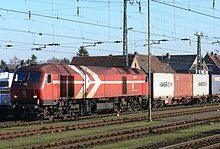DB class 240
| DB class 240 | |
|---|---|
|
DB 240 003-4 in Niebüll station
|
|
| Numbering: | DB 240 001-003 |
| Number: | 3 |
| Manufacturer: | MaK , Krupp and ABB |
| Year of construction (s): | 1989 |
| Axis formula : | Co'Co ' |
| Gauge : | 1435 mm ( standard gauge ) |
| Length over buffers: | 20,960 mm |
| Height: | 4175 mm |
| Width: | 2910 mm |
| Trunnion Distance: | 11,680 mm |
| Bogie axle base: | 3890 mm |
| Total wheelbase: | 15,650 mm |
| Smallest bef. Radius: | 100 m |
| Service mass: | 117.0 t |
| Top speed: | 160 km / h |
| Installed capacity: | 2650 kW |
| Starting tractive effort: | 405 kN |
| Driving wheel diameter: | 1016/936 mm |
| Motor type: | 12M282 |
| Rated speed: | 1000 rpm |
| Tank capacity: | 5000 l |
The diesel locomotives of the series 240 were in 1989 in cooperation with MaK , Krupp and ABB as EN 1024 made in three copies. In the meantime only the current DE 13 (owned by Rheincargo ) is still operational.
prehistory

The German Federal Railroad had completed its procurement program for mainline diesel locomotives with the 218 series . In accordance with DB's procurement criteria, only single-engine, four-axle machines were procured after the twin-engine V 200 . The drive was always diesel-hydraulic. The six-axle prototypes V 300 and V 320 were convincing in terms of performance, but were not (in series) procured. The DB planned to drive weaker machines in double traction if there was a corresponding power requirement .
With the Henschel-BBC DE 2500 , the locomotive industry built three modern prototypes of a four- or six-axle diesel-electric locomotive at its own expense in the 1970s. In addition to a very futuristic locomotive body , the three-phase drive is particularly noteworthy, i.e. H. Not only was the diesel-hydraulic drive concept broken, but the less-maintenance, but difficult-to-control three-phase motors were also used. After extensive testing, the Deutsche Bundesbahn showed no further interest in the DE 2500 either, so that some of it was rented to private railways . Further tests with the three-phase drive and new types of bogies were carried out on one example, the results of which were very important for the development of the 120 series and the ICE . This locomotive is now in the German Museum of Technology in Berlin .
Construction and technology
In the late 1980s, three new prototypes were built, which were designated as DE 1024. The six-axle locomotives, approved for 160 km / h, had a 2,650 kW diesel engine , which supplied the energy for the three-phase motors via a generator. The DE 1024 was designed as a multi-purpose locomotive. The diesel engine is started using compressed air .
The locomotives, which were completed in 1989, were rented by the Deutsche Bundesbahn in 1990 and tested extensively, particularly in northern Germany, but not purchased. From the DB's point of view, there was no real need, because on the one hand the electrification of further main lines in northern Germany and on the other hand the overhang of powerful diesel-electric locomotives of the Deutsche Reichsbahn series 232 that existed after reunification made an acquisition superfluous.
Whereabouts

After being returned by the DB, the locomotives made a detour to the HGK , where they were re-designated as DE 11-13. DE 11 and DE 12 were according to the driver's cab fires in the depot of HGK in Brühl-Vochem off. This makes DE 13 the last operational locomotive of this series.
The DE 12 locomotive was transferred from Brühl-Vochem to Kiel to the Voith factory in Kiel on July 25, 2009 and converted into a two-power locomotive as part of the EU CREAM project, which will be presented under the name Voith Futura. CREAM stands for customer-driven rail freight and is intended to revitalize freight traffic from the North Sea to the Bosporus.
Further developments
The DE 1024 was the inspiration for the DE 2700 from MaK (since 1998 Vossloh ) in terms of design and conception , which, however , made negative headlines both in Norway and at the NOB due to its vulnerability to damage . Further replicas are unlikely to be expected, as Vossloh now offers the Euro 4000 manufactured in Spain .
Web links
- Technical data and delivery list of all built DE 1024
- Locomotive portrait DE 13 (Ex-DB 240 003-4)
- Hybrid locomotive formerly MaK DE 1024 in new paintwork and high bracket ... Arbeitsgemeinschaft DREHSCHEIBE eV, Cologne , January 15, 2011, accessed on January 24, 2013 .
Individual evidence
- ^ Eisenbahn Journal, 11/2010: A dream in blue
- ↑ Press release from Hacon, September 23, 2010: EU-Project CREAM: European Commission impressed by the technological developments presented at the InnoTrans in Berlin (English)
